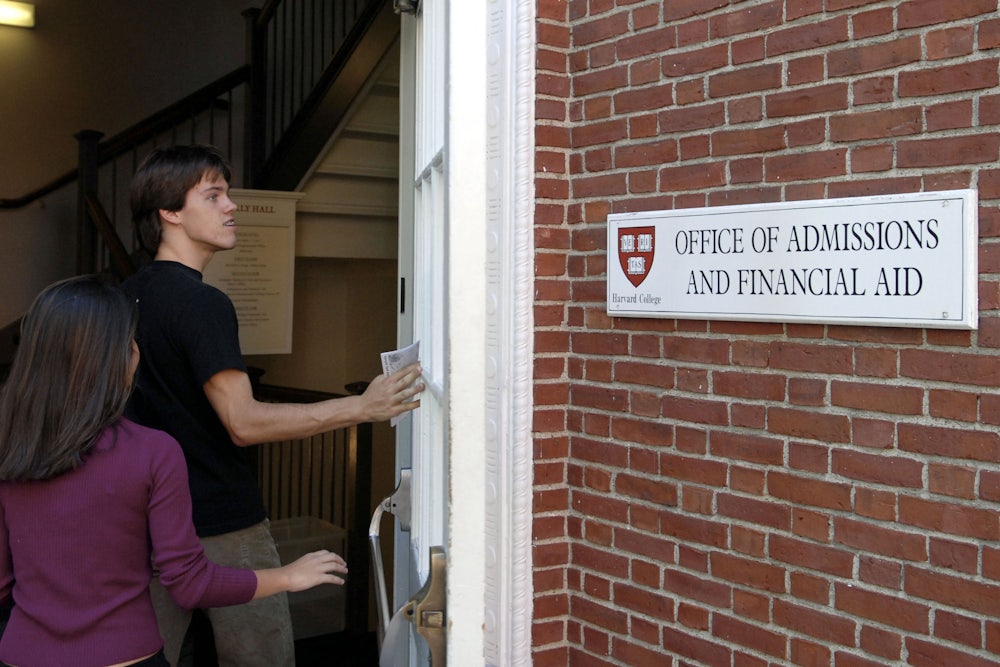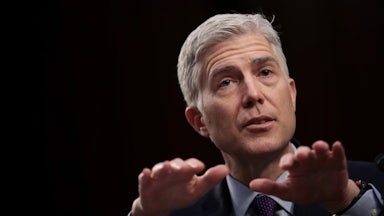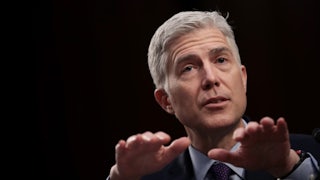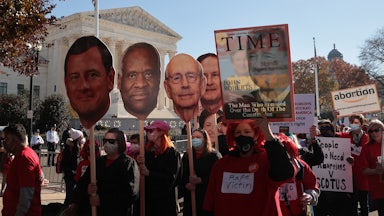The Supreme Court will hear a major legal challenge to affirmative action in higher education, the justices announced on Monday, foreshadowing the near-certain doom of those policies. The move adds yet another major social and political issue to the court’s docket as it already weighs sweeping decisions on abortion and gun rights. Moreover, it underscores how eager the court’s six-justice conservative majority is to rewrite American constitutional law in its own image, now that it is unencumbered by moderates and liberals.
The two cases attack race-conscious admissions policies on different fronts. In Students for Fair Admissions v. President & Fellows of Harvard, the plaintiffs argue that Harvard’s admissions policy violates Title VI of the Civil Rights Act of 1964, which generally forbids racial discrimination in private universities that receive federal funds. In Students for Fair Admissions v. University of North Carolina, which is aimed at public universities, the same plaintiffs argue that the school’s policy violates the Equal Protection Clause.
“The same Fourteenth Amendment that required public schools to dismantle segregation after Brown cannot be cowed by the diktats of university administrators,” the plaintiffs told the justices in their petition in the UNC case. “If California and Michigan can maintain elite public universities without sorting applicants by race, then North Carolina can, too.” They urged the court to overturn two precedents from 2003, Grutter v. Bollinger and Gratz v. Bollinger, that established the modern status quo on affirmative action in higher ed.
Both cases were brought by Students for Fair Admissions, or SFFA, a group founded by conservative legal activist Edward Blum for this exact purpose. Blum’s focus is on dismantling legislation and court precedents that attempt to remedy America’s history of racial discrimination. To that end, Blum has mounted legal campaigns to gut the Voting Rights Act of 1965, resulting in the court’s infamous 2013 ruling in Shelby County v. Holder, and served as a plaintiff in a Supreme Court case that successfully challenged minority-majority legislative districts.
Not all of Blum’s campaigns have been successful. 2016 saw two notable defeats for his causes. In Evenwel v. Abbott, the Supreme Court rejected an effort by one of the groups Blum leads to require states to use “total voting-age population,” as opposed to the national standard of total population, when drawing legislative districts. And in 2016, the justices ultimately upheld the use of race in the University of Texas’s admissions program in Fisher v. University of Texas, a long-running legal battle that Blum had helmed.
But that same year also saw an even greater victory for Blum’s legal activism: the election of Donald Trump. Anthony Kennedy, who wrote the court’s opinion in Fisher, retired in 2018. Ruth Bader Ginsburg, who died in 2020, had joined the opinion. Trump replaced them with Justices Brett Kavanaugh and Amy Coney Barrett, respectively. The two newcomers have not previously participated in a case involving the conscious use of race in college admissions. But they are both well-established members of the conservative legal movement, which generally abhors it.
In previous cases, the Supreme Court has held that colleges and universities can narrowly use race in the admissions process because students themselves can benefit from a more diverse student body. Those precedents will almost certainly be overruled. Justice Clarence Thomas, writing in dissent from one of the Fisher cases, described the policies as “racial engineering.” He argued that the “professed good intentions” of the University of Texas “cannot excuse its outright racial discrimination any more than such intentions justified the now denounced arguments of slaveholders and segregationists.”
SFFA’s briefs in both cases cite Thomas’s writings on affirmative action policies to bolster their argument, urging the court to adopt his interpretation of the Equal Protection Clause. They maintain that the universities’ policies have harmed students of other races and ethnicities who were denied admission to the universities. “Grutter sustains admissions programs that intentionally discriminate against historically oppressed minorities,” the group told the justices in its petition in the UNC case. “Jewish students were the first victims of holistic admissions, and Asian Americans are the main victims today.”
The lower courts rejected those arguments against both Harvard and UNC after extensive fact-finding, a point that both schools stressed in their responses to the petitions. “As the district court’s exhaustive and rigorous 155-page opinion shows, there can be no serious question that the university’s admissions process complies with this Court’s precedents,” UNC told the justices. “Perhaps for this reason, SFFA devotes very little of its petition to the actual facts of this case. Instead, SFFA attacks this Court’s settled precedents that the university has meticulously followed.”
Harvard, which won in the district court and in the First Circuit, also accused SFFA of misleading the justices. “Students for Fair Admissions’ petition recycles allegations both courts rejected and offers a thoroughly distorted presentation of the record,” the university told the court. “For example, SFFA contends that Harvard ‘automatically’ awards ‘enormous’ preferences to all African-American and Hispanic applicants, and ‘penalizes’ Asian-American applicants and caps their admission. The record and the district court’s findings refute those contentions.”
That criticism doesn’t appear to have dissuaded the justices from intervening in the case. If the justices overturn the court’s affirmative action precedents, the conservatives’ ultimate victory will be limited only because they have already largely won. As The Atlantic’s Adam Harris noted last year, “race-conscious admissions policies are weak, and used by only a smattering of the most highly selective programs,” falling far short of the remedial goals that the policies had originally been designed to achieve. The proportion of Black student enrollments at Ivy League schools, he wrote, has largely “stagnated” over the past 20 years, despite a series of Supreme Court rulings that upheld race-conscious policies—or perhaps because of them.
“In case after case the courts have drawn a tight circle where affirmative action can live; the colleges that step outside of it will be ordered back in by a judge,” Harris wrote. “In the Bakke decision, the Court made clear that the use of race in admissions could not be used as a remedy for past discrimination; instead, it had to be used as a tool for diversity—to benefit all the students on campus. An outline of Harvard’s program, the holistic admissions program that it still uses today (with small tweaks made over the years), was appended to the 1978 opinion.”
Still, a sweeping ban by the Supreme Court could have negative consequences for Black and Hispanic applicants. A 2020 study on the effects of California’s Proposition 209, which banned race-conscious admissions programs in state universities after voters approved it in 1996, found that the change led to worse outcomes for Black and Hispanic high school graduates in the state in virtually every metric. Admission rates and postgraduation earnings declined for both groups, without significant gains by white or Asian students. Labor economist Zachary Bleemer, the study’s author, said his finding could “provide the first causal evidence that banning affirmative action exacerbates socioeconomic inequities.”
That evidence, as well as the other factual arguments raised by the two universities, probably won’t dissuade the justices when they hear the case later this year. In her opinion for the court in Grutter in 2003, then-Justice Sandra Day O’Connor wrote that she hoped “that 25 years from now, the use of racial preferences will no longer be necessary to further the interest approved today.” By taking up the SFFA cases on Monday, the court’s conservative majority appears ready to call it quits six years ahead of schedule.










